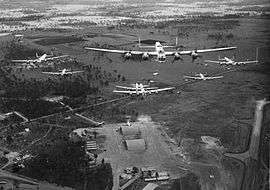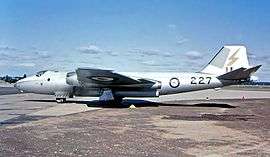No. 482 Squadron RAAF
| No. 482 Squadron RAAF | |
|---|---|
|
Inside the "Taj Mahal", No. 482 Squadron's main hangar at RAAF Base Amberley, on a typical day. Shown are General Dynamics F-111C swing-wing bombers and visiting CT/4 Airtrainers. | |
| Active | 1942–92 |
| Allegiance | Australia |
| Branch | Royal Australian Air Force |
| Role | Aircraft maintenance |
| Part of | No. 82 Wing (1946–92) |
| Garrison/HQ | RAAF Base Amberley |
| Motto(s) | Trenchant |
No. 482 Squadron was a maintenance unit of the Royal Australian Air Force (RAAF). It was formed in May 1942 as No. 4 Repair and Salvage Unit, renamed No. 4 Repair and Servicing Unit in January 1945 and re-formed as No. 482 (Maintenance) Squadron in May 1946. The squadron then became a component of No. 82 (Bomber) Wing at RAAF Station Amberley, Queensland. Over the years it serviced the wing's Consolidated B-24 Liberators, Avro Lincolns, English Electric Canberras, McDonnell Douglas F-4E Phantoms, and General Dynamics F-111Cs. No. 482 Squadron merged with No. 3 Aircraft Depot to form No. 501 Wing in March 1992. No. 501 Wing continued to provide maintenance and logistics support for the F-111Cs at Amberley until disbanding in 2001.
History
No. 4 Repair and Salvage Unit (RSU) was formed at RAAF Station Laverton, Victoria, on 18 May 1942. Its inaugural commanding officer, from 1 June, was acting Flight Lieutenant H.R.P. Relf. On 20 October, it commenced a move to Pell Airfield, Northern Territory, becoming operational on 26 December.[1][2] Coming under the control of North-Western Area Command (NWA), No. 4 RSU was responsible for salvaging damaged aircraft, which it subsequently repaired or dismantled for spare parts. By December 1943, its strength was over 500 officers and men.[1] It was renamed No. 4 Repair and Servicing Unit on 1 January 1945, and re-located to Winnellie, Northern Territory, on 11 May.[1][2] As the war in the Pacific moved northward, No. 4 RSU's strength was reduced; by August it was under 400, including 11 officers. On 15 December 1945, it moved to RAAF Station Parkes, New South Wales. The unit re-located from Parkes to RAAF Station Amberley, Queensland, on 15 April 1946.[1]

No. 4 RSU re-formed as No. 482 (Maintenance) Squadron on 10 May 1946. Commanded by Squadron Leader J.E. Jackson, it became a component of No. 82 (Bomber) Wing. The squadron's motto was "Trenchant".[3] No. 82 Wing's flying complement included Nos. 12, 21, and 23 Squadrons, but these were renumbered Nos. 1, 2 and 6 Squadrons respectively in February 1948. At the same time, the wing's Consolidated B-24 Liberator heavy bombers were replaced by Avro Lincolns.[4][5] During 1949–50, some of the Lincolns were specially modified with advanced radar and other instrumentation to participate in Operation Cumulative, a joint program with the Royal Air Force gathering long-range navigation and bombing data for use in potential air campaigns against the Soviet Union.[6] No. 482 Squadron faced a critical shortage of Merlin engines in mid-1950, but the situation improved the next year.[3]
In October 1950, No. 482 Squadron personnel undertook airframe and Avon engine courses in preparation for the introduction of the recently ordered English Electric Canberra jet bomber, forty-eight of which began re-equipping No. 82 Wing's flying squadrons in December 1953.[3][7] During the 1950s and 60s, No. 482 Squadron provided ground support for exercises involving the Canberras in Darwin and New Guinea, and for ceremonial occasions including several royal visits.[3] In April 1968, No. 1 Operational Conversion Unit (OCU), responsible for converting aircrew to the Canberra, was made independent of No. 82 Wing to concentrate on providing crews for No. 2 Squadron, which was on active duty in the Vietnam War.[8] Maintenance responsibilities for the Canberras then transferred from No. 482 Squadron to No. 1 OCU, along with relevant staff and equipment.[3]

Between 1970 and 1973, as an interim measure pending the long-delayed delivery of the General Dynamics F-111C swing-wing bomber, No. 82 Wing operated leased McDonnell Douglas F-4E Phantoms.[9] They were maintained by No. 482 Squadron in conjunction with No. 3 Aircraft Depot; as well as routine servicing, the units modified the Phantoms' AN/APQ-120 radars during early 1971.[10] No. 482 Squadron's hangar, electronics, and training facilities had been upgraded in the late 1960s in anticipation of the arrival of the F-111; the unit's main hangar became known as the "Taj Mahal".[11] By 1973, the year the F-111 finally entered service, No. 482 Squadron had a strength of over 700. Borrowing a concept from the United States Air Force, the RAAF employed a centralised servicing regime, whereby all aircraft and maintenance personnel were held by No. 482 Squadron, which serviced and released the F-111s in line with Nos. 1 and 6 Squadrons' joint flying program. According to Air Marshal Errol McCormack, an F-111 pilot who rose to become Chief of the Air Staff, the system was a "disaster" that was doomed to failure owing to the relatively small size of the RAAF's F-111 fleet.[12]
Responsibility for operational-level servicing of the F-111s was transferred to the flying squadrons on 1 February 1981. Under this arrangement, 200 personnel moved from No. 482 Squadron to Nos. 1 and 6 Squadrons, which for the first time took direct control of their F-111s.[3] No. 482 Squadron continued to provide intermediate-level servicing for the bombers, while major upgrades and complex maintenance involving stripping down the airframe and engines were carried out by No. 3 Aircraft Depot.[13][14] No. 482 Squadron also operated the F-111 flight simulator.[15] The squadron's personnel deployed with the F-111s on exercises, and took part in investigations and recovery operations following accidents.[3] On 17 March 1983, Sir Ninian Stephen presented No. 482 Squadron with the Governor-General's Banner.[16] No. 482 Squadron merged with No. 3 Aircraft Depot to form No. 501 Wing on 16 March 1992.[17][18] It became the largest unit in the RAAF, with a total strength of over 1,200.[18] No. 501 Wing continued to provide deep maintenance and logistics support for the F-111s at Amberley until 2001, when Boeing Australia was awarded the maintenance contract.[19][20]
Notes
- 1 2 3 4 RAAF Historical Section, Maintenance Units, pp. 88–89
- 1 2 Helson, The Forgotten Air Force, Appendix D
- 1 2 3 4 5 6 7 RAAF Historical Section, Maintenance Units, pp. 66–69
- ↑ "Avro Lincoln". RAAF Museum. Retrieved 30 March 2011.
- ↑ Wilson, Lincoln, Canberra and F-111, p. 48
- ↑ Stephens, Going Solo, pp. 445–449
- ↑ "Canberra". RAAF Museum. Retrieved 30 March 2011.
- ↑ Wilson, Lincoln, Canberra and F-111, p. 104
- ↑ Stephens, Going Solo, pp. 387–388
- ↑ Wilson, Phantom, Hornet and Skyhawk, p. 45
- ↑ Lax, From Controversy to Cutting Edge, p. 41
- ↑ Lax, From Controversy to Cutting Edge, p. 123
- ↑ Wilson, Lincoln, Canberra and F-111, p. 160
- ↑ Lax, From Controversy to Cutting Edge, p. 195
- ↑ Wilson; Pittaway, F-111 in RAAF Service, p. 48
- ↑ "Vice-regal". The Canberra Times. Canberra: National Library of Australia. 18 March 1983. p. 2. Retrieved 1 December 2013.
- ↑ RAAF Historical Section, Introduction, Bases, Supporting Organisations, pp. 119–123
- 1 2 Lax, From Controversy to Cutting Edge, p. 196
- ↑ Odgers, Air Force Australia, pp. 192, 218
- ↑ Lax, From Controversy to Cutting Edge, pp. 222–223
References
- Helson, Peter (1997). The Forgotten Air Force: The Establishment and Employment of Australian Air Power in the North-Western Area, 1941–1945 (Masters thesis). Canberra: Australian Defence Force Academy. OCLC 224054611.
- Lax, Mark (2010). From Controversy to Cutting Edge: A History of the F-111 in Australian Service. Canberra: Air Power Development Centre. ISBN 978-1-920800-54-3.
- Odgers, George (1996) [1984]. Air Force Australia. Frenchs Forest, New South Wales: National. ISBN 1-86436-081-X.
- RAAF Historical Section (1995). Units of the Royal Australian Air Force: A Concise History. Volume 1: Introduction, Bases, Supporting Organisations. Canberra: Australian Government Publishing Service. ISBN 0-644-42792-2.
- RAAF Historical Section (1995). Units of the Royal Australian Air Force: A Concise History. Volume 7: Maintenance Units. Canberra: Australian Government Publishing Service. ISBN 0-644-42798-1.
- Stephens, Alan (1995). Going Solo: The Royal Australian Air Force 1946–1971. Canberra: Australian Government Publishing Service. ISBN 0-644-42803-1.
- Wilson, Stewart (1989). Lincoln, Canberra and F-111 in Australian Service. Weston Creek, Australian Capital Territory: Aerospace Publications. ISBN 0-9587978-3-8.
- Wilson, Stewart (1993). Phantom, Hornet and Skyhawk in Australian Service. Weston Creek, Australian Capital Territory: Aerospace Publications. ISBN 1-875671-03-X.
- Wilson, Stewart; Pittaway, Nigel (2010). F-111 in RAAF Service 1973–2010: The Story of One of the Finest Strike Aircraft in Aviation History. St Leonards, New South Wales: Chevron.
Further reading
- Venn, Walter James (1999). Restore to Service: Unit History of No. 4 Repair and Salvage Unit (1942–1944) and No. 4 Repair and Servicing Unit (1945–1946). Australian Military History. ISBN 978-1-876439-30-9.
.jpg)